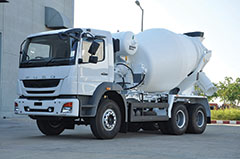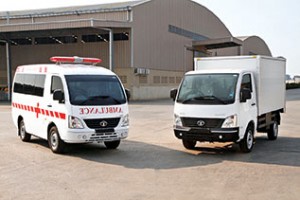Treading foreign shores, Indian commercial vehicles are eyeing advanced markets like Europe.
Story by: Ashish Bhatia
As the year draws to and end, exports are one of the positives the CV industry in India will remember for long. Low fuel prices not succeeding to uplift some of the CV segments in the domestic market, it is the exports that are a definite positive that the Indian commercial vehicle industry will look at with pride. Thrust on exports is growing. It is helping the Indian commercial vehicle manufacturers as well as the suppliers to gain valuable global insight in the process. Ravi Pisharody, Executive Director, Commercial Vehicle Business Unit, Tata Motors is known to have expressed that his company has been exporting for 20 years. He is also known to have said that they are ensuring every new CV they develop will conform to global standards, making it a potential candidate for exports. Apart from the Prime and Ultra, Tata Motors is banking on the Xenon and Ace to drive into new export markets. The CV manufacturer is making necessary changes and employing new technology to ensure that these vehicle address the needs of the local markets there. Rising beyond the SAARC region, Tata Motors is concentrating on Far East Asian markets like the Philippines, Indonesia, Malaysia and Vietnam. It is also concentrating on Australia and Africa, and has flagged off an assembly operation in Tunisia.
Right tech for the right market
CV exports, in the case of Tata Motors, is set to make the SuperAce Mint a familiar sight in the Thai market, which is also Asia’s largest pick-up truck market. Tata Motors already supplies the Xenon to this market. Australia, at the other end, is turning out to be a lead market for Tata Motors from the technology stand point. The OEM is looking at offering a pick-up truck with an automatic transmission there. Keeping away from Europe, which according to Pisharody, is an expensive proposition, Tata Motors is expecting an export growth of 30 per cent year-on-year.
Applying a good deal of export thrust, Daimler India Commercial Vehicles (DICV), under the aegis of Daimler Trucks Asia, is banking on the world-class trucks and bus (chassis) produced at Chennai. Working closely with Mitsubishi Fuso Truck and Bus Corporation (MFTBC), Japan, the OEM is exporting trucks to 14 markets spread across the Far East Asia and Africa. DICV trucks recently entered the South African market. From early this year, the bus chassis built at Oragadam in a dedicated plant begun exports to markets like Egypt where MCV builds the bodies and offers them as Mercedes-Benz. According to Erich Nesselhauf, Managing Director and CEO, DICV, exports of CVs built at Oragadam are part of DICV’s global growth strategy. To reach out to LHD markets, DICV ensured that its CVs could be suitably modified. Demonstrating interesting manufacturing flexibility, DICV began exporting its bus chassis well before it launched them locally, in the Indian market.
Eyeing advanced markets with world-class CVs
Despite being an expensive proposition, some Indian CV manufacturers are leveraging their European roots to export CVs to Europe. Volvo Buses India, for example, announced the export of its inter-city, twin-axle buses to Europe recently. Employing an imported Euro 6 powertrain, the buses are built on the same conveyor as the Indian buses. Conforming to the European standards and specifications, they are aimed at inter-city coach segment that typically does between 100 and 300 km. The Indian bus will thus compete against buses made by Diamler, Iveco and many European home grown brands. Claim industry sources, that one Volvo B8R single-axle chassis based bus was exported to Belgium in July 2015 from the Ennore port. Also, two B9R 9400 multi-axle buses are known to have been exported to South Africa during the same month; in March 2015 two more buses are claimed to have been exported to the same destination. In August 2015 seven B9Rs are claimed to have been exported to South Africa; one in September and two in October. Another Volvo Group company, Volvo Eicher Commercial Vehicles (VECV), is exporting its CVs to 25 countries. In this regards, Vinod Aggarwal, Chief Executive Officer, VECV, is known to have expressed that they are adapting the Pro series products according to specific country requirements. Aggarwal is also known to have mentioned that in South East Asian countries, the need is for better technology laden products that could compete with the Japanese products. VECV is thus adapting its products to address the specific needs and aspirations of those target markets.
A source close to Ashok Leyland revealed that the company is bullish about SAARC markets barring Pakistan. India’s largest bus manufacturer, Ashok Leyland has been catering to the Sri Lankan market through its local subsidiary Lanka Ashok Leyland for a long time. The company is known to have found a local partner in Nigeria to help with the assembly operations for buses. A similar arrangement is underway for the east African region. The operation capacities are expected to range between 2000 and 4000 units per annum. Ashok Leyland is also claimed to be chalking out plans to invade the Commonwealth of Independent States (CIS) and Latin American markets. Holding a 75.1 per cent stake in Optare plc., UK, Ashok Leyland has invested in a facility at Ras Al Khaimah, UAE, with a capacity to build 2,000 vehicles. If the Optare connection and Ras Al Khaimah facility reflect on Ashok Leyland’s exports aspirations, the company has won a USD 82 million (approximately Rs.521 crore) contract from Senegal to supply 475 buses as part of building Senegal’s comprehensive and integrated transportation system.
Lack of local prowess
As Indian CV manufacturers exert an export thrust, an interesting environment that they find themselves in is to compete with players that are of foreign origin; are from advanced markets of Europe, Japan, etc. A local player is often non existent. Pisharody is known to have commented on this, that there are no local commercial vehicles companies in many export markets, leaving them to compete with European manufacturers and those that are advanced market based. In such a situation, Indian companies seem to enjoy the price advantage with the support of products that are comparable or even superior in value terms. If companies like Nextmotive, which manufactures SCVs, are finding it advantageous to export to SAARC and African markets, it may be safe to assume that an Indian CV is well received, and has managed to make a good impression. The global markets, it said, have warmed up to Indian commercial vehicles.
The figures
What better way than to look at figures to understand the export drive of Indian CV OEMs. In the period between January 2015 and October 2015, 80,823 commercial vehicles were exported according to the SIAM data available. This marked a 13.4 per cent rise over the 71,303 numbers of commercial vehicles sold during the corresponding period last year. A closer look at the CV export data also reveals that a better gain was achieved beginning March 2015. September 2015 saw a dip with CV exports amounting to 7,672 units, a decline of (-) 5.95 per cent when compared to the sale of 8,157 units sold in September 2014. In October 2015, 8,168 units were exported marking a rise of close to 9 per cent when compared to the sale of 7,494 units in October 2014.
The march continues
Indian commercial vehicles are making in roads into new markets across the world. Their ability to match the specifications of competing products from manufacturers based in advanced markets is presenting them with a big price advantage. Indian commercial vehicles are turning out to be less costlier than those from the advanced market players by up to 35 per cent, claim some industry experts. The fact that some of the export markets are far behind in emission compliance, is actually leading to an amount of complexity at the Indian commercial vehicle manufacturer’s end. The quest for providing world-class commercial vehicles is not lost. It is in fact gaining momentum, albeit with an expectation that the conditions in the domestic market continues to improve. Exports are supportive no doubt, they are however not yet enough to offset the domestic slow down. The potential for exports therefore is immense.




























